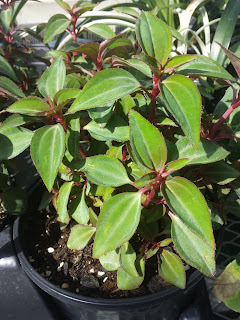Plant of the day is: Puya berteroniana or turquoise puya
Not that I don't approach every seed I sow with excitement, but every once in awhile, I come across a packet of seeds that I REALLY hope germinates. This is a story of that packet today.
Well then, do I have your attention? How about that color!? You just don't see that kind of color that often in nature, it's a treat. The contrast of the bright orange pollen is really something. It looks even better amassed on the inflorescence ...but more of that to come.
Taxonomy, etc.: We're back on another monocot. So you think pineapple and you'd probably think more tropical. Most bromeliads are tropical and found in the Americas, but this particular genus, Puya, can grow in some rather hostile places. While it is still a Bromeliaceae, it is more at home with cacti than palms, as you can see in the very bottom photo. The name Puya is derived from the Mapuche Indian word for point, which is easy to sympathize with when working with these plants. Gloves are non-optional. There are around 230 accepted species of Puya, so there is some nice diversity in the genus. Puya is one of the 51 genera in the Bromeliaceae much like the pineapple Ananas comosus and all those awesome air plants we all like so much, the Tillandsia. Puya is the type genus for the Puoideae subfamily. The classification of the family has seen a lot of attention based on chloroplast DNA analysis. Other notable genera in the family include Fosterella, Dyckia, Vriesea, and Guzmania. Some decent house plants in that lot. That doesn't mean the rest aren't equally amazing, I just don't know as much about them. Oh. Wittrockia is pretty awesome. It rocks.
Genus is credited to Juan Ignacio Molina, which I think is a great name. Actually from Chile himself, he wrote Saggio sulla Storia Naturale del Chili, one of the first accounts of the natural history of the country. He also has a lizard named after him. Nice.
Description: Forms large mounding rosettes of silver-grey leaves that are well armed with inward pointing spines that trap anything that falls into the rosette. They are pretty brutal. They are one species considered protocarnivorous, which is a fancy way of saying that they may trap and kill things but can't digest them directly, essentially just taking advantage of downward moving organic matter through the process of decay. Neat. The clumped rosettes can be over 1.5m tall by the way and the leaves are about a meter in length, pretty impressive. The flowers are a striking blue, which is a bit unusual as it selective for birds, as reds tend to attract other insects. In a pretty nifty morphological co-evolutionary feat, the flower stalks have lateral branches with flowers on the lower parts but ending in a stiff spur which is used as a perch for birds. Awww, nature is cute...when it's not being really diabolical. The inflorescence can be 2 to 4m tall, which is absurd and truly something to behold. These are what is called a monocarpic perennial, meaning they live for more than two years (can be several) and when they finally reach maturity, flower, and set seed, they die. This particular species takes bout 6-8 years to reach maturity, well worth the wait though.
Habitat/Culture: Hailing from the coastal mountains of Chile, it has adapted to live in a fairly hostile environment. You can see just how barren and dry its home is in the photo below. Because of its altitude it is actually fairly cold hardy, with reports of being hardy down to 15F in more xeric soils. I'd feel pretty comfortable with 22-25F degrees in a well drained but I doubt I'd feel comfortable pushing it any further than that. Not particularly difficult to germinate and grow if higher humidity in well drained soils is maintained throughout young growth. I think the danger with growing dry loving bromeliads and even cacti from seed is exposing them to harsh conditions too quickly. They can actually take a fair bit of water, and like the humidity, as long as the media is VERY well drained. I've got some very nice sized Puya coerulea var. monteroana that I've grown from seed this year and they're doing swimmingly in clay pots with lots of big chunk perlite, peat, and charcoal. Growing xeric plants is a rewarding lesson in managing watering, one I'm still learning.
Propagation: Will be trying these similar to my other Puya, essentially mimicking well established practices for cacti seed sowing and using well drained but peaty mixes that have been well sterilized. I actually use microwave safe deli/takeout containers and sterilize media with boiling water/microwave, sow seeds on surface, cover with good seal lid (allowing light in), place in greenhouse, and wait, impatiently at times.
Puya berteroniana, Paihuano, region de Coquimbo Photo Credit: Pato Novoa

































